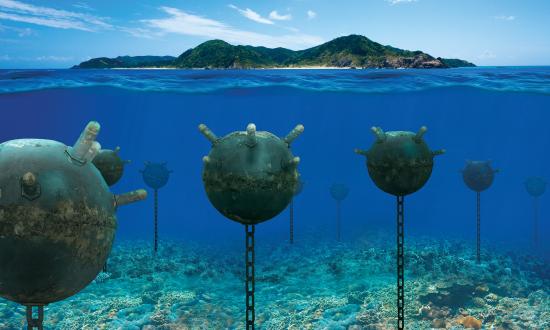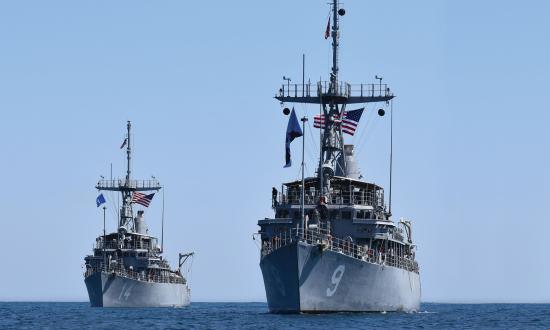The Navy and Marine Corps established expeditionary advanced base operations (EABO) as a foundational operating concept in 2019, and the Tentative Manual for Expeditionary Advanced Base Operations was signed in February 2021. The Marine Corps’ experiments with EABO are rapidly changing how and where the Marine Corps and supporting Navy formations will be organized, equipped, and deployed to compete and, if necessary, fight. Indeed, EABO is an intriguing operational concept well suited for great power competition in the Pacific, but naval mine warfare remains its missing ingredient.
EABO attempts to address potential adversaries’ advantages in geography and weapon system range, precision, and capacity “while creating opportunities by improving our own ability to maneuver and exploit control over key maritime terrain . . . by fully integrating Fleet Marine Force (FMF) and Navy capabilities to enable sea denial and sea control,” as well as fleet support and sustainment.1 The need for forward-deployed forces to reassure allies, partners, and friends while simultaneously deterring aggression, responding to crises, and enforcing international norms was well established before EABO. The difference now lies in the likelihood that an adversary’s anti-access and area-denial capabilities (that is, land-based and airborne long-range precision fires and mines) will pose significant threats to U.S. naval power projection during hostilities. EABO supports the joint force’s ability to operate in contested maritime terrain by having combat-credible forces in place before the “competition phase” turns to a crisis or conflict.2
Forward-deployed Marine Corps and Navy forces operating from expeditionary advanced bases in the littorals must be organized and equipped to shape the security environment ahead of conflict and prepared to fight if deterrence fails. Future forces—such as the proposed Marine littoral regiments (MLRs) and their supporting Navy littoral maneuver squadrons (LMSs) operating light amphibious warships—must rapidly transition from contact force activities to blunt force operations. During this transition and beyond, an MLR and LMS may be operationally isolated by an adversary’s activities and their own need to maintain low targeting profiles. The necessity for an MLR to persist inside the enemy weapons engagement zone (WEZ) requires a force that is relatively light, self-mobile, low-signature, and geographically distributed across its assigned area of operation to frustrate enemy targeting efforts. Persistence also requires that the future MLR can command, control, communicate, move, sense, logistically sustain, and defend itself in multiple domains against a peer adversary while remaining capable of projecting an effective area of influence over key littoral terrain. Naval mine warfare has a sizable role to play in meeting this latter requirement.
Inside Naval Mine Warfare
Postured as an inside force—inside the WEZ—in advance of conflict, MLRs will need to support sea-control operations, conduct sea denial, and contribute to maritime domain awareness under the joint force commander or the designated joint force maritime component commander. As such, they will support and integrate with joint kill chains by extending the range of surveillance, reconnaissance, and counter-reconnaissance for target identification and sharing with outside forces capable of striking from manned and unmanned platforms and long-range precision fires. In this role, an MLR might support the naval campaign through surface, antisubmarine, strike, and information warfare as well as missile and air defense.3 As currently envisioned, the MLR also should possess the capability to conduct a range of aviation tasks, such as reconnaissance, antiair and air defense, and forward arming and refueling operations. Mine warfare, however, is notably absent from the MLR’s current list of mission-essential tasks.
Naval mines frequently have disproportionate effects that extend beyond their tactical utility. Politically, mines have provided strategic messaging and imposed mobility paralysis on adversaries without sinking a single ship.4 They are excellent tools for limiting the use of overt force while likely posing less risk of vertical escalation than a missile or airstrike. They are deterrents, coercive tools, and force multipliers by their very presence. For rogue actors, terrorists, or even great powers, mines also are difficult to attribute.
Most modern sea mines are influence-triggered weapons that can select targets by their acoustic, magnetic, pressure, or other signatures. Target profiling by algorithms, ship-counting mechanisms, and self-propelled capabilities make sea mines that “lie in wait” semiautonomous weapons often more discriminating than bombs or missiles.5 They can be deployed on the seafloor, moored or tethered, before rising rapidly to close with a target across a wide cone of the water column above. They also can be released from ships and aircraft to drive or drift to a target zone. Technology advances strongly suggest future naval minefields will feature “controlled mines” that can be remotely armed and also send sensing and tracking data to friendly forces.
EABO and Mine Warfare: A Marriage of Convenience
With the sharpening focus of great power competition in the littoral regions, the threat of naval mining is high. Russia and China are the world’s premier mine builders, with vast inventories of mines of all types and advanced target-detection technologies. Each has invested heavily in the ability to conduct high-volume mining from submarines, a wide range of surface vessels, and aircraft that could quickly disrupt if not dictate U.S. operational maneuver and delay force-closure timelines while denying access to key littoral terrain and passage through strategic straits. The integration of tailored mine warfare capabilities with EABO offers a way to both counter the mine threat and strengthen an MLR’s lethal area of influence.
The Tentative Manual for Expeditionary Advanced Base Operations lists supporting sea-control operations and conducting sea-denial operations first among EABO missions.6 Both align well with the Navy’s list of objectives for naval mine warfare in conflict:
• Destroy adversary submarines and surface ships
• Enable local sea control
• Deny sea control and initiative to adversary forces
• Deny enemy use of ports, harbors, and coastal waterways
• Support friendly amphibious operations7
Mining and MCM operations also have a role in deterrence and coercion below the level of armed conflict, just as EABO has relevance across the competition continuum. The Joint Staff recognizes a broad range of vital functions enabled by mine warfare and MCM:
• Deter enemy use of naval mines
• Establish blockades to apply political leverage in a limited-war situation
• Protect ports and coastal lines of passage
• Open preplanned shipping lanes (Q-routes) and clear enemy mines from designated operating areas
• Deny the enemy the ability to carry out amphibious operations8
Technology development for EABO sea-denial enablers has largely focused on enhanced sensors, communication assets, unmanned vessels, air-defense capabilities, and antiship missiles. While these are valuable for deterrence below the threshold of armed conflict, they also are offensive capabilities that will likely draw attention—not to mention preemptive fires—when competition turns to conflict. The vital political access needed to establish EABs inside another sovereign nation’s territory could be jeopardized by the very capabilities deemed essential to their effectiveness in conflict. Host nations might foresee little advantage during competition but much potential harm in a conflict by allowing specific types of long-range kinetic weapon systems on their territories. Compared with missiles, MCM and naval-mining capabilities offer a more defensive posture with lower escalatory risks and greater asymmetric advantages. Furthermore, the technologies and tactics used in MCM create excellent partnership training opportunities (e.g., few developing countries have navies with any MCM capability) that support the host nation’s defensive and protective requirements.
Getting it Done
Without effective mine countermeasures in the early stages of regional hostilities, fleets must accept significant risk. Expeditionary MCM capabilities in forward operating areas could become indispensable enablers to mobility and sustainment—important elements for EABO’s success. Navy expeditionary warfare MCM companies or Marine explosive ordnance disposal detachments with MCM capabilities operating in direct support of deployed Marine littoral formations could enable protected, sustainable mine detection, classification, identification, and neutralization operations, helping other fleet assets avoid enemy minefields or maneuver through existing gaps. This will provide not only a tailored deterrent (or response) to enemy mining, but also the ability to quickly discern enemy intentions if a crisis escalates. Such early discernment can provide potent political leverage in the information realm and possibly help de-escalate a conflict.
When de-escalation fails and avoidance is not an option, enemy mines can be swept (deliberately triggered) or hunted (located, identified, and cleared individually) from the shore by specialized Navy and Marine Corps MCM forces with equipment prestaged at select EABs. Low-profile shore-based MCM sites that can launch, recover, and sustain unmanned/autonomous mine-detection and neutralization systems not only shorten the time required to open lanes through mined waters, but also lower the risk to higher-profile MCM surface ships, such as littoral combat ships, which may need to remain outside the WEZ.
Just as EABs can support early, integrated mine countermeasure operations, their ability to serve as mine dumps and support offensive and defensive mining inside the adversary’s WEZ offers another high-return-on-investment possibility. The clandestine laying of controlled mines—those that can be armed remotely—in competition or immediately after receiving unambiguous warnings of an imminent conflict—would contribute immensely to early efforts to establish sea control and prevent vertical escalation. In addition, mines offer a degree of survivability against enemy counterstrikes that other shore-based weapons available to an MLR cannot match. Minefield effects can endure, even if the enemy successfully disrupts, degrades, or destroys the EAB forces responsible for laying them. Unfortunately, few of the Navy’s current MCM platforms and none of its mines or delivery methods are suited for any of these scenarios.
But extra-large unmanned underwater vehicles (XLUUVs) such as the planned Orca could be instrumental in clandestine mining. EABs could refuel and maintain UUVs and download their mission data as well provide rapid mine reloads, dramatically reducing transit times and increasing minefield types, locations, sizes, and densities inside the WEZ. Other vessels of opportunity, such as the proposed light amphibious warship or long-range unmanned surface vessels, could be modified for rapid, high-volume mine-laying missions to supplement XLUUV mining. Extensive experimentation, tabletop exercises, and training will help determine the appropriate staffing, unit attachments, and logistical support requirements to operationalize this capability.
With great power competition among nuclear-armed rivals increasingly moving toward the high end of the scale and growing asymmetries in quantitative and qualitative warfighting capabilities, the value of military deterrence has rarely been greater. Mines can be used overtly for strategic messaging or clandestinely to add uncertainty and impose tactical surprise on an enemy’s anticipated freedom of maneuver.
Recognizing the need to change and adapt to new pacing threats, the Marine Corps has begun to shed capabilities, platforms, and employment practices not deemed essential for naval campaigning. It is seeking alternative means to regain its lethality as a forward-deployed force in readiness able to support sea denial and control of key littoral terrain. With a unified approach to next-generation mine development and fielding, the Navy–Marine Corps team can leverage expeditionary naval mine warfare to improve forward-based deterrence while providing survivable response options for sea-denial operations and the defense of key littoral terrain.
1. Office of the Chief of Naval Operations and Headquarters, U.S. Marine Corps, Concept for Expeditionary Advanced Base Operations (Washington, DC: Department of the Navy, 2019), 3.
2. Headquarters, U.S. Marine Corps, Tentative Manual for Expeditionary Advanced Base Operations (Washington, DC: Marine Corps, 2021), 1–3.
3. Marine Corps, Tentative Manual, B-1
4. The 1972 U.S. mining of Haiphong Harbor and other waterways in North Vietnam demonstrated how the mere presence of mines can shape enemy decisions and influence strategic success.
5. Ship-counting target-detection devices can defeat minesweeping attempts to trigger mines from stand-off and/or delay detonation to strike larger warships otherwise protected by a screening element.
6. Marine Corps, Tentative Manual, 1–5.
7. Office of the Chief of Naval Operations, Mine Warfare Plan: Meeting the Challenges of an Uncertain World (Washington, DC: Department of the Navy, 1992), viii.
8. JP 3-15: Barriers, Obstacles, and Mine Warfare for Joint Operations (Washington, DC: Joint Chiefs of Staff, 2018), IV–4–6.








